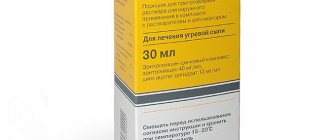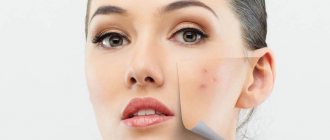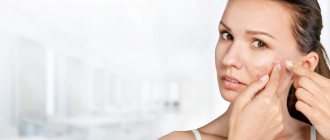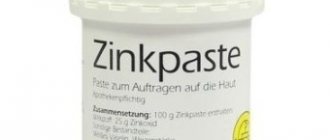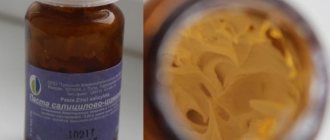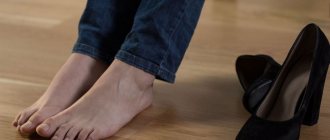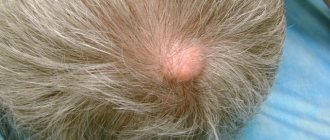Papular acne is the formation of papules on the skin, which are bumps with a hard consistency and a size of more than 1 centimeter. They are visible to the naked eye and can be felt under the finger when touched. Follicular lesions are mainly located on the facial skin in the T-zone, that is, on the forehead, nose and chin. This is an area of increased sebum and sebum production.
Papular acne is the most common and problematic form of acne. Treatment of papular acne requires medication and proper care.
Causes of formation of papular acne
The problem of papular acne mainly affects young people. In girls, this type of acne is usually more mild.
The changes that appear on the skin during the formation of papular acne are caused by the so-called hormonal storm. At a young age, hormone levels rise rapidly, causing the sebaceous glands to produce more sebum, which does not have time to be removed naturally.
Under physiological conditions, the production of sebum is necessary to create a protective layer on the skin that protects it from external factors. However, its excess, combined with exfoliating epidermis, sweat and dust from the environment, causes clogging of the sebaceous tubules and the appearance of acne, nodules and papules.
Bacteria multiply under the skin, and an inflammatory reaction develops, which is manifested by pain, pinpoint swelling and redness of the facial skin.
Papular acne in adults is caused by excessive stress, inadequate facial care, or problems with hormone (androgen) secretion. The most common problem of adult acne occurs in women, such as during menstruation or pregnancy. Papular changes are accompanied by pimples and acne.
How to treat subcutaneous acne?
Before removing a subcutaneous pimple using a Uno spoon or other instrument, you should think carefully about whether you can do this without aggravating the situation. Inept squeezing out of rashes often leads to the spread of the inflammatory process, skin damage, scar formation, and hyperpigmentation spots. This way you will get rid of acne, but your skin will not become more beautiful, just one aesthetic defect will be replaced by another.
It is important to learn to treat acne as a disease that needs to be treated, and not just get rid of the symptoms.
Clindovit® gel is a medicine for subcutaneous acne. It is a topical antibiotic that can be used to treat mild to moderate acne.6
It is better to learn from a specialist about how to get rid of subcutaneous acne. He will find out what caused the acne, prescribe medications, home care, and may also recommend cosmetic procedures that will help improve the condition of the skin.
An integrated approach to combating subcutaneous rashes is the most correct. But it should be remembered that even those procedures that are intended to treat acne may be contraindicated for acne if we are talking about inflammatory elements (papules, pustules, cysts).
Antimicrobials for treating acne at home
For inflammatory elements of acne in the form of papules and pustules, antibacterial drugs for external use can be used independently, since they do not have the pronounced effectiveness of systemic antibiotic therapy.
Topical preparations suppress the growth of bacteria:
- Benzoyl peroxide (Baziron AS) gel.
- Azelloic acid (Skinoren) gel and cream.
- Fusidic acid ointment, cream.
- Erythromycin ointment.
- Clindamycin (Dalacin-gel).
- Lincomycin ointment.
- Metronidazole gel.
- Pyolysin ointment.
- Zenerite (erythromycin/zinc acetate) powder.
- Zinc hyaluronate (Curiosin) gel.
Degrease and disinfect the skin with alcohol solutions with antibiotics (5% chloramphenicol), 2% resorcinol, 2 - 5% salicylic acid solution, 5 - 10% alcohol solution of camphor.
Don't squeeze pimples! When squeezed, the infection spreads into the deep layers of the skin and non-inflamed elements.
Effective treatment for facial acne
First of all, when you contact our clinic, your attending physician will tell you what tests to take for acne. These include:
- general blood analysis;
- analysis for the content of hormones, microelements, vitamins B12 and B6;
- analysis for luteinizing hormones of the pituitary gland (for menstrual irregularities in women).
Treatment for acne in teenagers is not always necessary. The usual pubertal rash goes away on its own, as sometimes happens with atopic dermatitis, which disappears with age. It is enough just to analyze and create a competent diet. In addition, the teenager will be advised to take proper skin care. The same scheme is used to treat acne in adults, but additionally take measures to eliminate the cause of acne. It can be:
- treatment of diseases of the gastrointestinal tract, adrenal glands, etc.;
- the use of antibacterial drugs if the cause is the proliferation of pathogenic bacteria;
- quitting smoking and alcohol.
Nutrition for acne is especially important. It is worth starting treatment with dietary correction before going to the doctor. At the PsorMak clinic, to increase the effectiveness of the diet, it is formulated individually. In most cases, it excludes milk, which worsens the skin condition. Foods with a high calorie content and glycemic index also increase the sensitivity of receptors to androgens. These include all sweets, bread, white rice, potatoes.
Acne treatment in Moscow at the PsorMak clinic necessarily includes local therapy using a safe non-hormonal ointment. The use of hormones for acne can only worsen the condition, and also cause a withdrawal effect, when after the end of the use of hormonal ointment, acne appears again, and in even greater quantities.
By contacting our clinic, you will never encounter this situation. We use only the most effective and proven treatment methods, the results of which you can see on the website in a special section. And remember, the sooner you see a doctor, the more effective the treatment of acne on the face will be, especially when it comes to the aesthetic appearance of the skin.
Etiology and pathogenesis
The main sex hormones that regulate the activity of the sebaceous glands are androgens . They affect the development and increase in the size of the sebaceous glands in androgen-dependent areas of the skin, the hyperproduction of sebum and the proliferation of keratinocytes in the ducts of the sebaceous glands, the hair canal and the mouths of the pilosebaceous follicles.
According to the inflammatory concept of acne, the chain of pathogenetic events begins with androgen-induced inflammation of the sebaceous gland . This causes proliferation and active desquamation of keratinocytes in the upper part of the pilosebaceous follicles. Progressive hyperkeratosis and the associated difficulty in the outflow of sebum lead to the formation of comedones , which subsequently transform into papules and pustules or spontaneously regress.
Overproduction of sebum contributes to changes in its qualitative composition. In sebum, the concentration of linoleic acid decreases, which suppresses the expression of transglutaminase and is involved in the synthesis of the main components of the intercellular matrix. This leads to an increase in the pH of sebum and a change in the permeability of the walls of the follicles and the stratum corneum of the epidermis.
Sebum stagnation creates anaerobic conditions that are optimal for the proliferation of propionibacterium acnes in the pilosebaceous follicles. They secrete substances that damage the walls of ducts and glands, as well as factors that attract neutrophils.
The release of lysosomal enzymes by neutrophils further reduces the strength of the follicle wall, which ultimately leads to their rupture. The contents enter the dermis, where local inflammation develops according to the “foreign body reaction” type.
Exogenous factors contributing to the development of acne:
- taking sex hormones, anabolic steroids ( Fig. 1 );
- high glycemic index diet;
- smoking;
- whole milk;
- fast food;
- chocolate;
- various occupational hazards;
- hot and humid climate.
Rice. 1. Acne on the shoulder and back of an athlete due to the use of anabolic steroids (Danish national service on dermato-venereology)
https://www.danderm-pdv.is.kkh.dk/atlas/4-120-9.html
Diagnosis of acne
Depending on the complexity, clinical examination and laboratory tests are used.
A clinical examination is sufficient in most cases of acne. The dermatologist carefully examines the skin, collects anamnesis (information about past illnesses, operations, chronic disorders, heredity) and asks you about your lifestyle, nutrition, and habits.
If the nature of the disease is not identified, tests are prescribed.
Clinical studies measure levels of luteinizing hormone, dehydroepiandrosterone sulfate, follicle-stimulating hormone and testosterone.
Tests for bacterial and fungal cultures are also taken, and differential diagnostics are carried out.
It is worth understanding that the course of the disease is individual and there cannot be a single solution for everyone. For example, in men, acne is much more complicated, especially in athletes after taking anabolic steroids.
Forecast
Acne treatment always takes time, so the patient must be patient. During the treatment process there can be both improvements and deteriorations; periods of remission and intensification of the disease alternate. But over time, acne will respond to treatment.
In the absence of timely treatment, acne can progress to a severe stage, in which painful cysts form in large quantities, leaving behind deep scars. In addition, acne can significantly reduce the patient's self-esteem and lead to problems with social communication.
Types and stages of acne
There are 4 degrees of severity of acne:
- First. There are no inflammations or pustules yet, but there are closed comedones in the form of white rashes.
- Second. Open comedones, i.e. blackheads, also appear. Against their background, you can notice inflamed lumps and isolated pustules. Their number already exceeds 20 elements.
- Third. The number of inflamed elements and pustules reaches 40 pieces.
- Fourth. There are very large lumps and nodules on the skin, many ulcers, more than 40 pieces.
Skin cleansing is an essential component of daily care.
Daily cleansing of the skin is a must when treating acne on the face and other parts of the body. Foams, gels and lotions are used for this purpose. They remove excess oil and do not dry out the skin. It is not recommended to use soap. The frequency of washing when treating acne should not exceed 1 - 2 times a day.
- Cleansing gel (France) cleanses the skin well. In this case, the hydrolipid film is not damaged.
- The cleansing gel is part of the Exfoliak series of medicinal cosmetics (France).
- Cleansing lotion and gel for washing are included in the preparations of the Klerasil Ultra series.
- Gel for cleansing facial skin is part of the products of the Cetaphil, Sebium and Sphingogel series.
- Cleansing gel for oily skin is part of the Zeniak series.
Degrease and disinfect the skin with alcohol solutions with antibiotics (5% chloramphenicol), 2% resorcinol, 1 - 2% salicylic acid solution, 5 - 10% alcohol solution of camphor.
Frequent washing leads to increased dryness of the skin and a decrease in its protective properties.
Cleansed skin is treated with tonic. For acne, preference should be given to tonics that contain keratolytics and comedolytics. These products have the ability to exfoliate dead cells, prevent the accumulation of sebum and horny scales in the mouths of the follicles, and reduce inflammation.
Rice. 20. The photo shows acne on the face.
Reducing sebum production, normalizing the processes of keratinization and death of epidermal cells, suppressing microflora and reducing inflammation are the basic principles in the treatment of acne.
Causes of acne
According to various sources, acne appears in 65-95% of people, that is, in the absolute majority. Their appearance in itself is not a cause for concern. Acne can be caused by changes in the body and hormonal changes.
But if acne continues to appear after 25, this is a reason to visit a specialist.
Main reasons:
— Endocrine system disorders. The main purpose of the endocrine glands is to produce hormones. With their help, the body’s activity and its adaptation to the external environment are regulated. Acne can be a signal that one or more glands are not working properly. The most common triggers for acne are testosterone, dihydrotestosterone, dehydroepiandrosterone, and insulin-like growth factor 1.
— Diseases of the gastrointestinal tract. Gastrointestinal diseases provoke the growth of pathogenic flora, which release toxins (products of their vital activity) into the blood: fungi, bacteria, parasites. As a result, skin diseases develop: acne, dermatitis, eczema, etc.
— Genetics. There is a hereditary predisposition in which the sebaceous glands are overly sensitive to testosterone.
- Chronic infections.
— Zinc deficiency.
- Stress. On the one hand, this is a natural reaction to negative external factors. On the other hand, stress affects hormonal levels, the functioning of the gastrointestinal tract, and can worsen the course of acne.
There can be many reasons. Acne is a symptom of one or a number of diseases. To understand the essence of the problem, you need professional diagnostics.
If you only remove the consequences (with creams or peelings, for example), then all this will only give a temporary effect.
